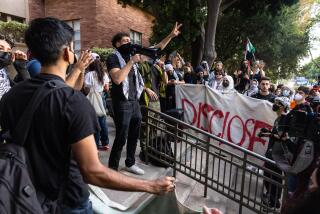Victims’ mothers drawn into Egypt protests
Reporting from Cairo — Day laborer Mohammed Badr clearly didn’t expect trouble when he left home to join the pro-democracy protests in Tahrir Square early on Jan. 29. He took his 5-year-old son, Mahmoud, and promised to return for dinner.
“He kissed me goodbye and said, ‘Don’t be afraid,’” his mother, Sabrine, said Wednesday. “Then he looked me in the eye and said, ‘You are not my real mother. Egypt is my real mother. I must go save her.’”
Friends brought the boy home safe that afternoon, but the family didn’t learn of Badr’s fate until nightfall. He had been shot through the chest, and his body lay in a makeshift morgue at the edge of the square.
“He gave his life for his country,” his mother said, sobbing. “He’s a hero, and will live forever for Egypt.”
Badr, 32, was among 24 people killed in Tahrir Square by unidentified gunmen in the early days of the demonstrations that have convulsed Egypt and shaken President Hosni Mubarak’s autocratic regime. A 25th victim, a woman, died after she was clubbed in the head.
Protest leaders increasingly are using such victims, whom they call “martyrs to the revolution,” and their grieving mothers, to keep passions stoked as Egypt’s tumult enters a third week. Anonymous in life, but venerated nationally in death, the victims serve as reminders of government brutality and rallying cries for each new protest and parade.
Huge photos of several of the slain — some bloodied and bruised, their wounds displayed in grisly detail — adorn fences around the square. Smaller photos were carried like religious icons in grim processions through the throngs Wednesday. The chanting crowd hailed the victims as martyrs, a potent symbol for the mostly-Muslim protesters, and praised their mothers for their sacrifice.
Mothers of several victims showed up in the square for the first time Wednesday. A crowd gathered around Nawal Sayed as she alternately wept, shouted and waved a poster of her 18-year-old son, Mohammed Refaat, a waiter who was shot and killed Jan. 29.
“I’m here to tell everyone the story so people will know what happened!” she shouted. “We want justice! We want these people to go to jail!”
A mock burial mound also appeared in the square Wednesday. A smiling photo of 17-year-old Khalid Mohammed, who was fatally shot, was tucked into rocks painted red, white and black, the colors of the Egyptian flag.
“We want to make sure people do not forget this bloodshed,” said Mohammed Abbas, 26, an advertising executive who as a protest leader has helped organize the victims campaign.
Abbas and 13 others with five political groups — four of them officially banned by the government — meet twice daily in a green-and-white camping tent at the center of the square to devise strategy for bringing down Mubarak’s government, including appropriate signage for the revolution.
The posters provide enough poignant details for protesters to identify with victims they never knew.
Ahmad Bassiony, who had thick curly hair and a stubble, taught art. Mohamed Metwaly Awad, who had dark eyes and a shy smile, was engaged to be married. Ahmad Mohamed Mahmoud was a news photographer. Alkarim Ahmad Ragad was in his fourth year at the science college.
None of the killers has been identified.
Dr. Khaled Hanafy, who coordinates the makeshift medical clinics on the square, said 14 people were shot and killed on Jan. 29 during clashes with state security and police officers. Eleven more died Feb. 2 and early the next morning when armed pro-government demonstrators surged into Tahrir Square, he said.
All but one of the victims was shot in the head or chest, he said. “No one was running away,” he said.
A young woman named Sally Zahran died of blunt force trauma after she was clubbed in the head. Her poster-sized photo also hangs at several spots in the square. In it, she appears to be laughing, her face framed by long curly hair.
How many were killed outside Tahrir Square is unknown, and the government has not released an official toll. Human Rights Watch estimated this week that more than 300 people had died across Egypt, including 232 in Cairo, 52 in Alexandria and 18 in Suez.
But lawyers at the Hisham Mubarak Law Center, a prominent legal advocacy group in Cairo, said Wednesday that those figures appeared too low based on police reports and local estimates from human rights groups across the country. It said about 980 people may have died so far.
The higher estimate also includes a number of deaths in villages and towns that were not counted in other tallies, said Ahmed Ragheb, director of the law center.
Ragheb said his researchers had fully documented “more than 200” deaths, including confirmed identifications, time of death and cause of death.
Times staff writer Kim Murphy contributed to this report.
More to Read
Sign up for Essential California
The most important California stories and recommendations in your inbox every morning.
You may occasionally receive promotional content from the Los Angeles Times.











